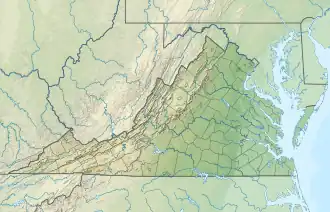| Spesard Knob | |
|---|---|
 Location of the Spesard Knob wild area in Virginia | |
| Location | Craig County,Virginia, United States |
| Coordinates | 37°27′47″N 80°4′55″W / 37.46306°N 80.08194°W |
| Area | 2,084 acres (8.43 km2) |
| Administrator | U.S. Forest Service |
Spesard Knob, a wildland in the George Washington and Jefferson National Forests of western Virginia, has been recognized by the Wilderness Society as a special place worthy of protection from logging and road construction. The Wilderness Society has designated the area as a "Mountain Treasure".[1]
With 226 acres of possible old growth forest and unfragmented habit for black bear, the area offers a unique off-trail hiking experience in a remote forest near New Castle.[1] The area is part of the Craig Creek Cluster.
Location and access
The area is located in the Appalachian Mountains of Southwestern Virginia, about 3 miles south of New Castle, Virginia. State Route Va 618 passes along the eastern and southern side of the area.[2] A powerline separates the area from the Broad Run wild area on the north.[2]
There are no trails or roads into the area.[3]

The boundary of the wildland, as determined by the Wilderness Society, is shown in the adjacent map.[1] Additional roads in the vicinity are given on National Geographic Maps 788 (Covington, Alleghany Highlands).[2]
Beyond maintained trails, old logging roads can be used to explore the area. The Appalachian Mountains were extensively timbered in the early twentieth century leaving logging roads that are becoming overgrown but still passable.[4] Old logging roads and railroad grades can be located by consulting the historical topographic maps available from the United States Geological Survey (USGS). The Spesard Knob wild area is covered by USGS topographic map Catawba.[1]
Natural history
The area is within the Ridge and Valley Subsection of the Northern Ridge and Valley Section in the Central Appalachian Broadleaf Coniferous Forest-Meadow Province.[5] A shale barren, the Broad Run barren, is on the western side of the area.[3] Shale barrens in western Virginia provide habitat for the Appalachian grizzled skipper.[6]
Although small, the area forms an important wildlife corridor between the Broad Run wild area to the north and North Mountain on the southeast.[2]
Several old growth tracts have trees as old as 140 years of age or older.[3]
Topography
The area includes several peaks over 2000 feet elevation, including the 2034-foot[7] Spesard Knob on the southwestern side of the area. Spesard Knob is part of a mountain complex at the southern end of Broad Run Mountain where Craig Creek has breached the ridge that continues as Sinking Creek Mountain on the south.[2]
Broad Run flows along the southeastern side of the area. Lick Branch, on the north boundary of the area, drains into Craig Creek. Other streams in the area are also part of the Craig Creek drainage, a tributary of the James River.[2]
Forest Service management
The Forest Service has conducted a survey of their lands to determine the potential for wilderness designation. Wilderness designation provides a high degree of protection from development. The areas that were found suitable are referred to as inventoried roadless areas. Later a Roadless Rule was adopted that limited road construction in these areas. The rule provided some degree of protection by reducing the negative environmental impact of road construction and thus promoting the conservation of roadless areas.[1] Spesard Knob was not inventoried in the roadless area review, and therefore not protected from possible road construction and timber sales.[3]
The Cuba wildfire in 2008 burned a large part on the north side of the area as well as part of the adjacent Broad Run wild area.[3]
The forest service classifies areas under their management by a recreational opportunity setting that informs visitors of the diverse range of opportunities available in the forest.[8] Most of the area is designated "Backcountry-Non Motorized". A portion on the western tip is designated as "Rare Community".[3]
See also
References
- 1 2 3 4 5 "Report issued by The Wilderness Society". Virginia's Mountain Treasures: 22. May 1999.
- 1 2 3 4 5 6 Trails Illustrated Maps (2001). Covington, Alleghany Highlands (Trails Illustrated Hiking Maps, 788). Washington, D. C.: National Geographic Society.
- 1 2 3 4 5 6 Bamford, Sherman (February 2013). A Review of the Virginia Mountain Treasures of the Jefferson National Forest. Blacksburg, Virginia: Sierra Club, OCLC: 893635467. pp. 42–43.
- ↑ Sarvis, Will (2011). The Jefferson National Forest. Knoxville, Tennessee: University of Tennessee Press. ISBN 1-57233-828-8.
- ↑ Revised Land and Resource Management Plan for the Jefferson National Forest, Management Bulletin R8-MB 115E. Roanoke, Virginia: Jefferson National Forest, US Department of Agriculture. 2004. pp. C-31–C-36.
- ↑ Chazel, Ann C.; Roble, Steven M.; Hobson, Christopher S.; Derge, Katharine L. (2004). "Status of the Appalachian Grizzled Skipper (Pyrgus centaureae wyandot) in Virginia" (PDF). Banisteria. 24: 15–22. Retrieved February 24, 2019.
- ↑ "Feature Detail Report for: Spesard Knob". Geographic Names Information System. Retrieved 24 February 2019.
- ↑ "Recreation Opportunity Setting as a Management Tool" (PDF).
Further reading
- Stephenson, Steven L., A Natural History of the Central Appalachians, 2013, West Virginia University Press, West Virginia, ISBN 978-1933202-68-6.
- Davis, Donald Edward, Where There Are Mountains, An Environmental History of the Southern Appalachians, 2000, University of Georgia Press, Athens, Georgia. ISBN 0-8203-2125-7.